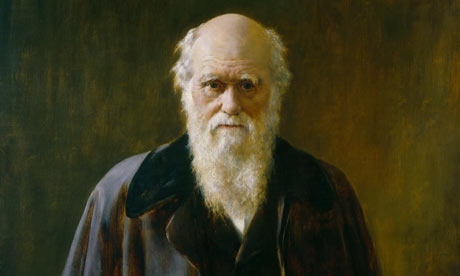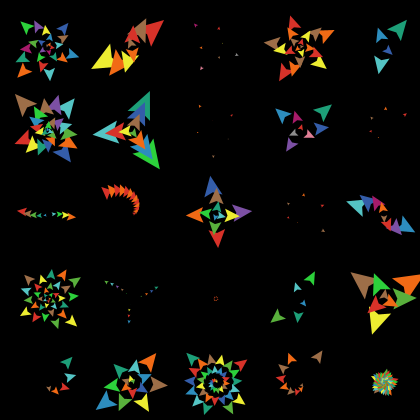Thursday, January 29, 2009
Autonomous Robots Invade Retail Warehouses
"Warehouses run by Gap, as well as Zappos and Staples now use autonomous robots to pluck products from their shelves and send them to you". Full story @ Wired.com
Tuesday, January 27, 2009
Life As We Know It Nearly Created in Lab
"Researchers, at the Scripps Research Institute, created [RNA] molecules that self-replicate and even evolve and compete to win or lose." Full story @ LiveScience


Monday, January 26, 2009
Evolution of Darwin
"Among a glut of new works on the great naturalist, Philip Ball finds the claim that a hatred of slavery motivated his studies". Full article @ The Guardian


Funny video
I don't love Dawkins, but I do love this! Thanks Olmy!
Yeah he's the Dick to the Dawk to the PhD...
Labels: creationism, Darwin, Dawkins, evolution
Artificial Life on Nova
The PBS show Nova explored recent advances in Artificial and Synthetic Life. See the segment.


Labels: Artificial Life, synthetic life
Book Available in TIS Bookstore
Nunes de Castro, Leandro [2006]. Fundamentals of Natural Computing: Basic Concepts, Algorithms, and Applications. Chapman & Hall. On half.com. On Amazon.com. On Google Books.
Labels: materials, natural computing
Thursday, January 22, 2009
Why Darwin was wrong about the tree of life
Recommended by David Alsip:
"The tree-of-life concept was absolutely central to Darwin's thinking, equal in importance to natural selection[...]. Many biologists now argue that the tree concept is obsolete and needs to be discarded." Full article @ The New Scientist

"The tree-of-life concept was absolutely central to Darwin's thinking, equal in importance to natural selection[...]. Many biologists now argue that the tree concept is obsolete and needs to be discarded." Full article @ The New Scientist

Immune memory debate heats up
"New findings stir the coals of a hot debate in immunology regarding the origin of memory T cells." Full article @ The Scientist


Wednesday, January 21, 2009
Evolution's challenge to genetics
Do conjoined twins and two-legged goats suggest a minor role for genetics in evolution? The evidence is not strong enough to upset the orthodox view, argues Jerry A. Coyne. Full article @ Nature


Monday, January 19, 2009
An epigenetic inheritance
"It's not just genes that are inherited. Chemical tags that affect gene expression levels may be inherited too". News report @ The Scientist, Full article @ Nature Genetics.
Labels: epigenesis, heritability
Saturday, January 17, 2009
A bilingual genetic code
Messenger RNA is used as a template to assemble proteins by means of three-letter sequences called codons. Each codon corresponds to either a single amino acid or a 'stop' signal. However, Vadim Gladyshev of the University of Nebraska in Lincoln and his colleagues found that in E. crassus, the codon UGA could encode two amino acids: cysteine or selenocysteine.
The codon could be read in both ways within the same gene, depending on its location within the mRNA strand and the presence and exposure of a specific sequence near the end of the mRNA molecule. The results suggest that the genetic code can be evolutionarily expanded.
Full article @ Nature

The codon could be read in both ways within the same gene, depending on its location within the mRNA strand and the presence and exposure of a specific sequence near the end of the mRNA molecule. The results suggest that the genetic code can be evolutionarily expanded.
Full article @ Nature

Exploring Consciousness through the Study of Bees
"Bees display a remarkable range of talents—abilities that in a mammal such as a dog we would associate with consciousness". Full article @ Scientific American


Labels: intelligence, Swarms
Thursday, January 15, 2009
The weird structure of Vaults
An intriguing but poorly understood structure, broadly distributed in eukaryotic cells, is a large ribonucleo-protein particle termed a vault--so named because electron microscopy revealed a complex morphology resembling the multiple arches of cathedral vaults. More @ Science/AAAS


On the Origin of Life on Earth
"In the first of a monthly series of essays celebrating the Year of Darwin, Carl Zimmer discusses attempts to unravel how life originated on Earth by recreating the process in the laboratory." Full Story @ Science


iGEM
From Seth Frey:
The International Genetically Engineered Machine (iGEM) is coming to Bloomington. It is a contest built on a set of standards that enable students to design novel organisms for engineering purposes with minimal capital and training.
The most fascinating projects I have found are:
-E. Coli that generates peppermint smell when it is growing and banana smell when it stops
-Another organism that emits a red dye if it is in arsenic laced water; providing a cheap arsenic test.
-Photosensitive E.Coli; literal biofilm. In the attached flier, you see a print of the classic "Hello World". There can be no more overt demonstration of the intent to turn biology into engineering/programming.
These are organisms engineered by students with a toolkit of standardized genes. The callout next Thursday is to recruit a team to participate in iGEM2009. Bioengineering experience is not required. The contest was started at MIT and in the past four years has grown from 5 to 84 participating schools from around the world.
WhereWhenWhat-to-eat:
Thursday, January 22
6:00 pm to 7:00 pm
Jordan Hall room 239
Pizza at 5:45 pm
And for your browsing pleasure:
iGEM 2008 is the most recent contest.
The Registry of Standard Biological Parts, in which a 'part' is a gene that has been modified to suit the easy-to-work-with BioBrick standard.
OpenWetWare provides tech support.

The International Genetically Engineered Machine (iGEM) is coming to Bloomington. It is a contest built on a set of standards that enable students to design novel organisms for engineering purposes with minimal capital and training.
The most fascinating projects I have found are:
-E. Coli that generates peppermint smell when it is growing and banana smell when it stops
-Another organism that emits a red dye if it is in arsenic laced water; providing a cheap arsenic test.
-Photosensitive E.Coli; literal biofilm. In the attached flier, you see a print of the classic "Hello World". There can be no more overt demonstration of the intent to turn biology into engineering/programming.
These are organisms engineered by students with a toolkit of standardized genes. The callout next Thursday is to recruit a team to participate in iGEM2009. Bioengineering experience is not required. The contest was started at MIT and in the past four years has grown from 5 to 84 participating schools from around the world.
WhereWhenWhat-to-eat:
Thursday, January 22
6:00 pm to 7:00 pm
Jordan Hall room 239
Pizza at 5:45 pm
And for your browsing pleasure:
iGEM 2008 is the most recent contest.
The Registry of Standard Biological Parts, in which a 'part' is a gene that has been modified to suit the easy-to-work-with BioBrick standard.
OpenWetWare provides tech support.

Labels: synthetic biology
Wednesday, January 14, 2009
Synthetic genomes brought closer to life
An entire bacterial genome has been reconstructed by stitching together chemically synthesized DNA fragments, bringing the prospect of an artificial living organism one step closer. Full story @ Nature Biotechnology
The actual paper by Gibson et al detailing the process of obtaining a synthetic genome.

The actual paper by Gibson et al detailing the process of obtaining a synthetic genome.

Labels: bacteria, synthetic biology
The Scientist : Is This Life?
Is This Life?, from The Scientist examines new research on the topic of Synthetic Life, or what was also described in class as Wet Artificial Life.


Labels: synthetic life
Tuesday, January 13, 2009
Putting Evolution to Use in the Everyday World
"Understanding of evolution is fostering powerful technologies for health care, law enforcement, ecology, and all manner of optimization and design problems." Full article @
Scientific American: Special Issue on Darwin

Scientific American: Special Issue on Darwin

Labels: evolution
Monday, January 12, 2009
Biology's Gift to a Complex World
"How studying biological interactions and evolution yields techniques for predicting the outcome of complex interactions". By John Holland @ The Scientist


Labels: biology, complexity, genetic algorithms
R
"R is also the name of a popular programming language used by a growing number of data analysts inside corporations and academia. It is becoming their lingua franca partly because data mining has entered a golden age, whether being used to set ad prices, find new drugs more quickly or fine-tune financial models." Full Story @ NYTimes.com
Labels: Programming
NetLogo Home Page
NetLogo is a cross-platform multi-agent programmable modeling environment. NetLogo was authored by Uri Wilensky in 1999 and is under continuous development at the CCL (the people who brought you StarLogoT). NetLogo also powers the HubNet participatory simulation system. NetLogo is free of charge. For a fuller description, go to the NetLogo Home Page.
Make sure to check the Sunflower Biomorphs.

Make sure to check the Sunflower Biomorphs.

Labels: Programming
Slow Down, Multitaskers; Don’t Read in Traffic
Confident multitaskers of the world, could I have your attention? Think you can juggle phone calls, e-mail, instant messages and computer work to get more done in a time-starved world? Read on, preferably shutting out the cacophony of digital devices for a while. Full article @ New York Times


Labels: multitasking
The Evolution of Evolution
The January 2009 issue of Scientific American is a wonderful special issue on Darwin and the Theory of Evolution. Read it for Class.


Labels: evolution


